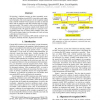Free Online Productivity Tools
i2Speak
i2Symbol
i2OCR
iTex2Img
iWeb2Print
iWeb2Shot
i2Type
iPdf2Split
iPdf2Merge
i2Bopomofo
i2Arabic
i2Style
i2Image
i2PDF
iLatex2Rtf
Sci2ools
INTERSPEECH
2010
2010
Similarity scoring for recognizing repeated out-of-vocabulary words
We develop a similarity measure to detect repeatedly occurring Out-of-Vocabulary words (OOV), since these carry important information. Sub-word sequences in the recognition output from a hybrid word/sub-word recognizer are taken as detected OOVs and are aligned to each other with the help of an alignment error model. This model is able to deal with partial OOV detections and tries to reveal more complex word relations such as compound words. We apply the model to a selection of conversational phone calls to retrieve other examples of the same OOV, and to obtain a higher-level description of it such as being a derivation of a known word.
Alignment Error Model | Complex Word Relations | INTERSPEECH 2010 | Partial Oov Detections | Signal Processing |
| Added | 18 May 2011 |
| Updated | 18 May 2011 |
| Type | Journal |
| Year | 2010 |
| Where | INTERSPEECH |
| Authors | Mirko Hannemann, Stefan Kombrink, Martin Karafiát, Lukas Burget |
Comments (0)

